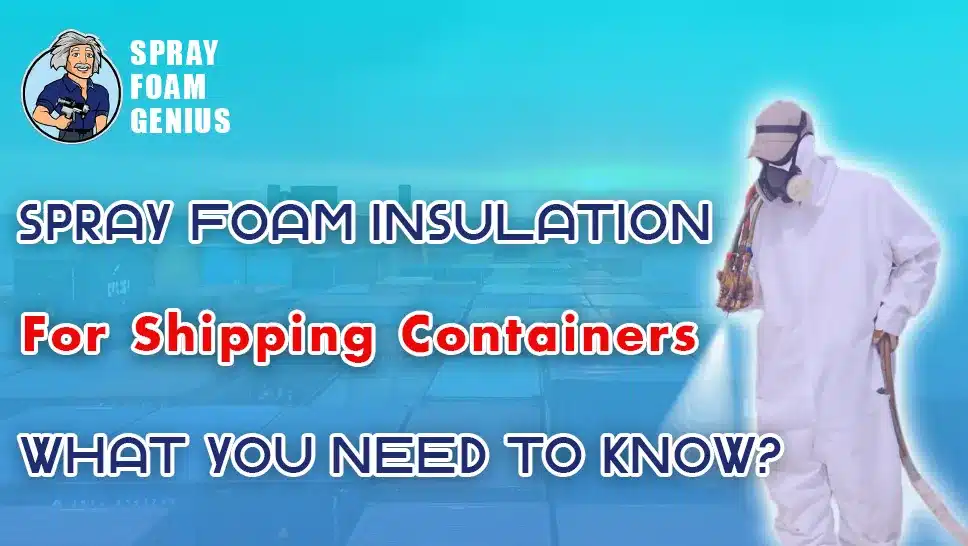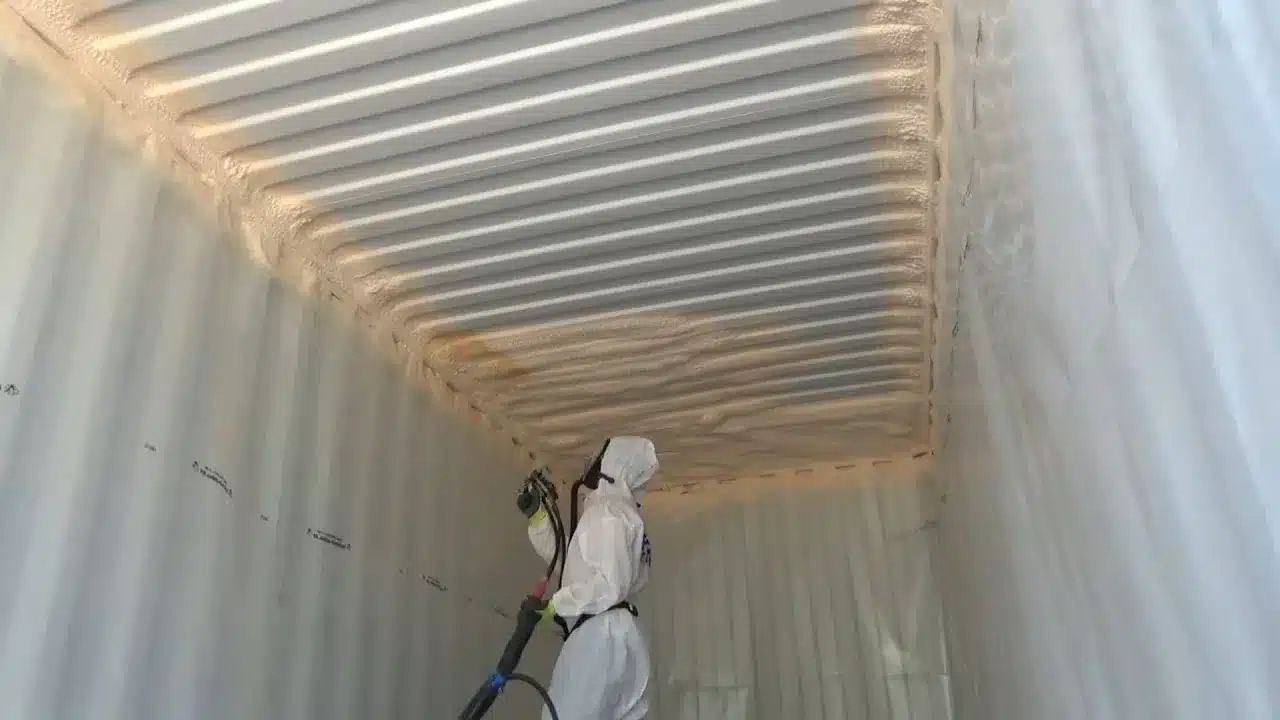
In the ever-evolving construction landscape, spray foam insulation has become a cornerstone for creating energy-efficient, durable, and versatile spaces. Among its many applications, spray foam insulation for shipping containers is gaining significant traction. As spray foam insulation contractors, understanding this niche market can open new avenues for your business, especially in the USA and Canada, where shipping container conversions are increasingly popular. This comprehensive guide will walk you through the essentials of spray foam insulation for shipping containers, helping you to deliver superior service to your clients.
Why Shipping Containers?
Shipping containers are increasingly being repurposed for various uses, from homes and offices to storage units and pop-up shops. Their durability, affordability, and availability make them a popular choice for eco-friendly construction projects. However, due to their metal structure, shipping containers can be prone to extreme temperatures, condensation, and rust if not properly insulated. This is where spray foam insulation comes into play, offering an effective solution to these challenges.
The Benefits of Spray Foam Insulation for Shipping Containers
Spray foam insulation provides several key benefits when used in shipping containers:
1. Superior Thermal Insulation
Shipping containers are made of steel, which conducts heat, making them susceptible to extreme temperature fluctuations. Spray foam insulation helps maintain a stable internal temperature, providing excellent thermal resistance (R-value). Closed-cell spray foam, in particular, offers a higher R-value per inch compared to traditional insulation materials, making it ideal for the confined spaces of shipping containers.
2. Moisture and Vapor Barrier
Condensation is a common issue in shipping containers due to their metal structure. Spray foam insulation creates an airtight seal, preventing moisture from penetrating the container walls. This barrier reduces the risk of mold, mildew, and rust, thereby extending the container’s lifespan.
3. Structural Strength
Closed-cell spray foam not only insulates but also adds structural strength to the container. This is particularly beneficial for containers used in harsher environments or those that require additional load-bearing capacity.
4. Noise Reduction
Spray foam insulation also acts as a sound barrier, reducing noise from outside sources. This is an important feature for shipping containers repurposed as homes, offices, or other spaces where noise control is crucial.
5. Energy Efficiency
The superior insulating properties of spray foam reduce the need for heating and cooling, leading to significant energy savings. This is a major selling point for clients looking to lower their carbon footprint and utility bills.
Choosing the Right Type of Spray Foam
There are two primary types of spray foam insulation: open-cell and closed-cell. Each has its advantages, but for shipping containers, closed-cell spray foam is generally the preferred choice due to its density, higher R-value, and water-resistant properties.
Closed-Cell Spray Foam
- Density: Higher, providing greater structural support.
- R-Value: Approximately 6.5 per inch, making it ideal for spaces where maximum insulation is needed with minimal thickness.
- Water Resistance: Acts as a vapor barrier, preventing moisture infiltration and reducing the risk of condensation and rust.
- Best Use Cases: Containers in extreme climates, or those used for living spaces, offices, or other insulated applications.
Open-Cell Spray Foam
- Density: Lower, making it less rigid but more flexible.
- R-Value: Around 3.5 per inch, which is lower than closed-cell but still effective for certain applications.
- Water Resistance: Does not act as a vapor barrier, so it’s less suitable for areas prone to moisture.
- Best Use Cases: Interior partitions or in combination with other insulation types in non-critical areas.
Application Process: Best Practices
The application of spray foam insulation in shipping containers requires precision and expertise. Here’s a step-by-step guide to ensure the best results:
1. Preparation
Before applying spray foam, the container must be thoroughly cleaned and dried. Any rust or corrosion should be treated, and the metal surface should be primed if necessary. This step is crucial to ensure proper adhesion of the spray foam.
2. Safety Measures
Working in a confined space like a shipping container requires strict adherence to safety protocols. Ensure proper ventilation and use protective gear, including masks and gloves, to prevent exposure to chemicals.
3. Application Technique
Spray foam should be applied in layers to achieve the desired thickness. For closed-cell foam, aim for a thickness of at least 2-3 inches to maximize insulation and structural benefits. It’s important to apply the foam evenly to avoid gaps and ensure a continuous barrier.
4. Finishing
After the foam has cured, any excess material can be trimmed. If the container’s interior will be finished with drywall or another surface, ensure the foam surface is even and ready for installation.
5. Quality Control
Inspect the finished work for any gaps, voids, or inconsistencies. Properly applied spray foam should create a seamless, airtight barrier. Address any issues before considering the job complete.
Potential Challenges and How to Overcome Them
Spray foam insulation for shipping containers is not without its challenges. Here are some common issues and tips on how to address them:
Condensation
Even with spray foam, condensation can occur if the container is not properly ventilated. Consider installing vents or an HVAC system to manage humidity levels.
Limited Space
Shipping containers have limited space, and adding too much insulation can reduce the usable area. This is why closed-cell spray foam, with its high R-value, is often preferred.
Cost
While spray foam insulation can be more expensive upfront compared to other insulation types, its long-term benefits in energy savings, durability, and moisture protection often justify the investment. Educate your clients on these benefits to help them see the value.
Adhesion Issues
Proper surface preparation is key to preventing adhesion issues. Ensure the container surface is clean, dry, and free from rust or debris before applying the spray foam.
Expanding Your Business with Spray Foam Insulation for Shipping Containers

As more clients look to convert shipping containers into livable or workable spaces, the demand for quality insulation will continue to rise. By offering spray foam insulation specifically tailored for shipping containers, you can expand your business and tap into this growing market. Emphasize the unique benefits of spray foam, such as superior thermal performance, moisture resistance, and structural reinforcement, to differentiate your services from competitors.
Why Choose Spray Foam Genius Marketing for Your Business?
At Spray Foam Genius Marketing, we specialize in helping spray foam insulation contractors grow their businesses through expert SEO, Google My Business optimization, and lead generation. Our deep understanding of the spray foam industry, combined with our cutting-edge marketing strategies, positions your business for success. We tailor our services to meet the unique needs of spray foam contractors in the USA and Canada, ensuring you attract more clients and dominate your local market.
Ready to Boost Your Business?
If you’re ready to take your spray foam insulation business to the next level, Call us at 877-840-FOAM for USA and 844-741-FOAM for Canada visit our website at sprayfoamgeniusmarketing.com, or email us at [email protected] to get started.
Let’s work together to ensure your business stands out in the competitive market of spray foam insulation for shipping containers.
- 5 Google My Business Hacks to Double Your Leads for Spray Foam Insulation Contractors - January 14, 2025
- Why Spray Foam Contractors Cannot Ignore Reputation Management in 2025 - January 13, 2025
- Local SEO Secrets Every Spray Foam Contractor Must Know to Win in 2025 - January 13, 2025

